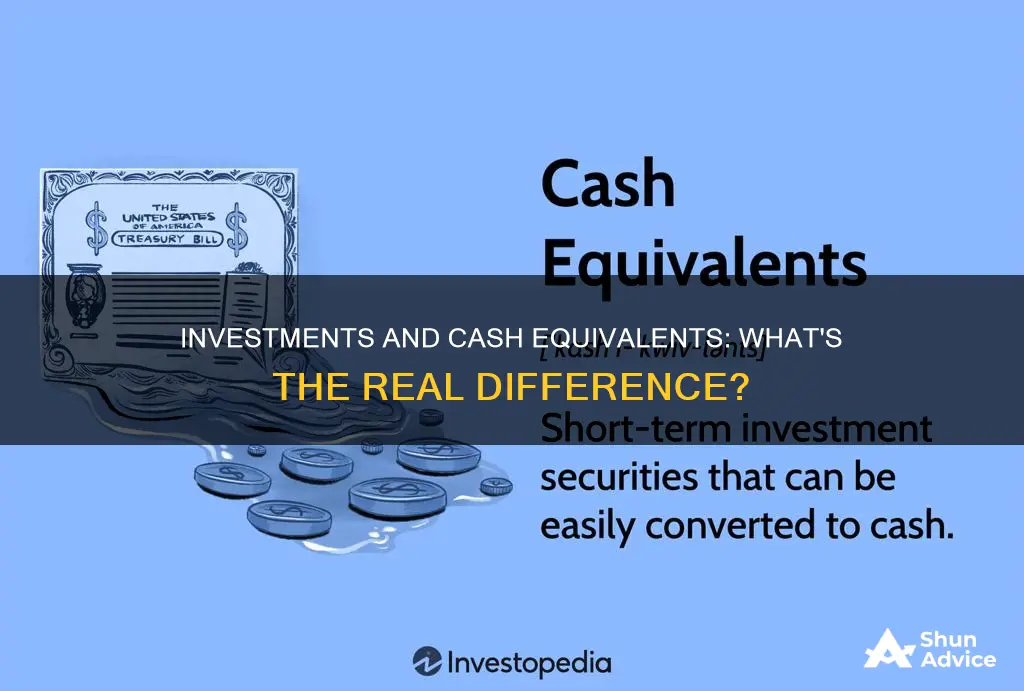
Cash and cash equivalents are a line item on a company's balance sheet that reports the value of its assets that are either cash or can be converted into cash immediately. Cash equivalents include bank accounts and some types of marketable securities, such as debt securities with maturities of less than 90 days. They are highly liquid, low-risk, and short-term investments. Examples include treasury bills, commercial paper, money market funds, and certificates of deposit. Cash and cash equivalents are important for a company's financial health and ability to meet short-term obligations.
| Characteristics | Values |
|---|---|
| Maturity | 90 days or less |
| Liquidity | Highly liquid |
| Convertibility | Readily convertible to known amounts of cash |
| Risk | Low-risk/low-volatility |
| Accessibility | Unrestricted access |
What You'll Learn

What are cash and cash equivalents?
Cash and cash equivalents are a line item on a company's balance sheet. They represent the value of a company's assets that are either cash or can be converted into cash immediately. Cash and cash equivalents are current assets, meaning they are the most liquid of short-term assets.
Cash is money in the form of currency, including bills, coins, and currency notes. It also includes money orders, cashier's checks, certified checks, and demand deposit accounts such as checking and savings accounts.
Cash equivalents include bank accounts and some types of marketable securities with maturities of less than 90 days, such as debt securities, commercial paper, and short-term government bonds. They are highly liquid and easily sold on the market, with well-known market prices and minimal price fluctuations.
The total value of cash and cash equivalents is always shown at the top of a company's balance sheet. This is because they are current assets that can be used to meet short-term debt obligations and pay off current liabilities. Companies with healthy amounts of cash and cash equivalents are generally viewed as being able to meet their financial obligations.
Investing: Negative Cash Flow's Impact and Insights
You may want to see also

What are the characteristics of cash equivalents?
Cash equivalents are securities meant for short-term investing and are considered equivalent to cash because they can be converted to actual cash quickly. They are a line item on the balance sheet that reports the value of a company's assets that are cash or can be converted into cash immediately.
Cash equivalents have the following characteristics:
- Liquidity: Cash equivalents must trade in liquid markets, making it very easy to convert to cash.
- Short-term Investment: Cash equivalents must be convertible to cash quickly and have a short-term maturity.
- Low-Risk/Volatility: Cash equivalents are a low-risk, low-volatility investment option for cash on hand.
- Unrestricted Access: Conversion of cash equivalents to cash should be unrestricted and on-demand.
Cash equivalents include US government T-bills, bank certificates of deposit, bankers' acceptances, corporate commercial paper, and other money market instruments. They are important indicators of a company's financial health and ability to pay short-term obligations.
Cash Investment Strategies: Your Guide to Profitable Opportunities
You may want to see also

What are the benefits of cash equivalents?
Cash equivalents are highly liquid, low-risk investments that can be converted into cash quickly. They are important for companies as they are a good indicator of their financial health and ability to pay short-term debts.
There are several benefits to cash equivalents:
- They can be used to meet short-term obligations: Cash equivalents are part of a company's net working capital, which is used to pay for operating expenses, buy inventory, and cover debt servicing.
- They can help build an emergency fund: Companies can use cash equivalents to handle unexpected costs and protect themselves during slow business periods or economic downturns.
- They can be used for future projects: Companies can invest added cash in cash equivalents to capitalise on business opportunities when they arise, rather than locking capital into long-term, illiquid investments.
- They can be required by debt agreements: Lenders may require companies to maintain a certain amount of liquid cash equivalents to protect their financial interests. This can also result in better loan terms for the company.
- They can provide a return on investment: Cash equivalents often yield higher interest rates than a basic bank account, providing some protection against inflation.
- They can be used to mitigate the effects of a financial recession: Companies can quickly convert cash equivalents to cash to fund their operations after exhausting their readily available money.
- They can provide a source of passive income: When companies store capital as cash equivalents, they can gather interest.
CDs: Cash or Investment?
You may want to see also

What are the drawbacks of cash equivalents?
Cash equivalents are a vital part of a company's balance sheet, but they also come with certain drawbacks. Here are some of the disadvantages of cash equivalents:
- Lower Returns: While cash equivalents offer higher interest rates than cash in a basic bank account, they often earn significantly lower returns compared to other longer-term and less liquid investments. For capital growth and increasing the value of a business, investing in the company or opting for higher-yielding, higher-risk ventures may be more lucrative.
- Risk of Default: Cash equivalents are backed by their issuers, typically governments or corporations. There is a risk, however, that the issuing entity may default. In such cases, investors may not receive the agreed-upon return. Federal Deposit Insurance (FDIC) coverage for depositors at federally-insured financial institutions is limited to $250,000.
- Early Redemption Fees: Certain cash equivalents, such as Certificates of Deposit (CDs), may impose fees or fines for early redemptions. This can be a disadvantage if access to funds without penalties is required.
- Opportunity Cost: Holding too much cash or cash equivalents can result in an opportunity cost for a company. This idle cash could be invested in projects with the potential to generate additional income. By keeping cash idle, businesses may miss out on opportunities to generate higher returns and increase their overall value.
- Increased Cost of Capital: According to the Corporate Finance Institute, excess cash can lead to a higher cost of capital. This is because the cost of capital represents the minimum rate of return a business must generate to create value for shareholders.
- Management Complacency: Having substantial cash reserves may lead to management complacency, increasing the risk of damaging the business value.
Extra Cash: Where to Invest for Maximum Returns
You may want to see also

How do cash and cash equivalents appear on a balance sheet?
Cash and cash equivalents are a line item on a company's balance sheet that reports the value of its assets that are either cash or can be converted into cash immediately. This line item is always shown on the top line of the balance sheet because they are current assets, meaning they are the most liquid of short-term assets.
Cash is money in the form of currency, which includes all bills, coins, and currency notes. It also includes money orders, cashier's cheques, certified cheques, and demand deposit accounts.
Cash equivalents include bank accounts and some types of marketable securities, such as debt securities with maturities of less than 90 days. They should be highly liquid and easily sold on the market. Examples include:
- Treasury bills
- Commercial paper
- Short-term government bonds
- Banker's acceptance
- Money market accounts
- Certificates of deposit
Cash and cash equivalents are used by companies to pay short-term bills and to preserve capital for long-term capital deployment. They are also used to meet short-term debt obligations and to save for future capital investments.
Cash App Investment Options: Where to Put Your Money
You may want to see also
Frequently asked questions
Cash and cash equivalents (CCE) are the most liquid current assets found on a business's balance sheet. They include actual cash on hand and securities that are similar to cash.
Cash is the direct ownership of a government-issued currency, which can take the form of physical cash or digital cash in a bank account. Cash equivalents are short-term, highly liquid investments that are not yet immediately available for use but can be converted to actual cash quickly.
Examples of cash equivalents include Treasury bills, commercial paper, money market funds, certificates of deposit, and short-term government bonds.
Cash and cash equivalents are important indicators of a company's financial health and liquidity. Analysts can estimate a company's ability to pay its short-term obligations and bills by comparing CCE with current liabilities.
The opportunity cost of holding CCE is the return on equity that a company could earn by investing in new products, services, or business expansion. Companies with large amounts of cash and cash equivalents may be targets for acquisitions by larger companies.







